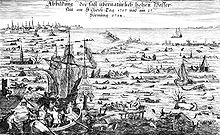The Frisians are an ethnic group indigenous to the coastal regions of the Netherlands,north-western Germany and southern Denmark,and during the Early Middle Ages in the north-western coastal zone of Flanders,Belgium. They inhabit an area known as Frisia and are concentrated in the Dutch provinces of Friesland and Groningen and,in Germany,East Frisia and North Frisia.

Rungholt was a low-lying settlement in North Frisia,in what was then the Danish Duchy of Schleswig. The area today lies in Germany. Rungholt was flooded,with massive erosion,when a storm tide hit the coast on 15 or 16 January 1362.
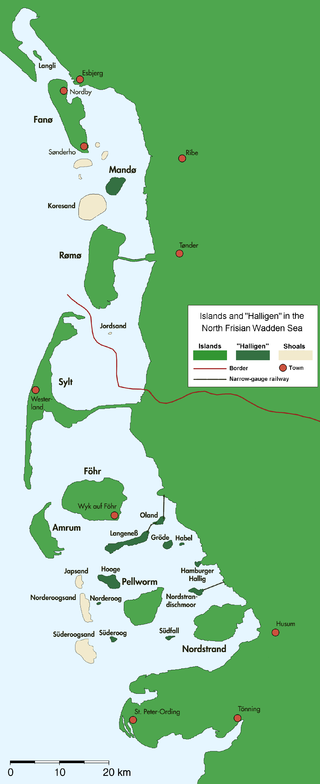
The North Frisian Islands are the Frisian Islands off the coast of North Frisia.

Frisia is a cross-border cultural region in Northwestern Europe. Stretching along the Wadden Sea,it encompasses the north of the Netherlands and parts of northwestern Germany. Wider definitions of "Frisia" may include the island of Rem and the other Danish Wadden Sea Islands. The region is traditionally inhabited by the Frisians,a West Germanic ethnic group.
Leer is a district (Landkreis) in Lower Saxony,Germany. It is bounded by the city of Emden,the districts of Aurich,Wittmund,Friesland,Ammerland,Cloppenburg and Emsland,and by the Netherlands.

Storm tides of the North Sea are coastal floods associated with extratropical cyclones crossing over the North Sea,the severity of which is affected by the shallowness of the sea and the orientation of the shoreline relative to the storm's path,as well as the timing of tides. The water level can rise to more than 5 metres (17 ft) above the normal tide as a result of storm tides.
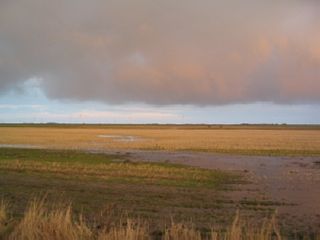
A koog or groden is a type of polder found on the North Sea coast of Germany that is established by the construction of dykes enclosing the land which is then drained to form marshland. This type of land reclamation is also used along rivers. In general,a koog is protected by embankments known as dykes (Deiche).

The 1953 North Sea flood was a major flood caused by a heavy storm surge that struck the Netherlands,north-west Belgium,England and Scotland. Most sea defences facing the surge were overwhelmed,resulting in extensive flooding.
The All Saints' Flood of 1570 occurred on November 1–2,1570 in the Spanish Netherlands,and is considered the worst North Sea flood disaster before the 20th century. It flooded the entire coast of the Netherlands and East Frisia. The effects were felt from Calais in Flanders to Jutland and even Norway. Even though the alleged casualty figures were mostly based on rough estimates and should be viewed with skepticism,up to 25,000 deaths can be assumed.
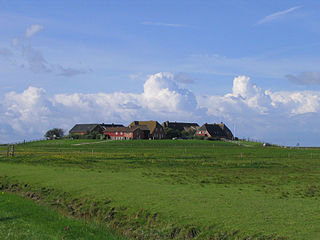
A terp,also known as a wierde,woerd,warf,warft,werf,werve,wurt or værft,is an artificial dwelling mound found on the North European Plain that has been created to provide safe ground during storm surges,high tides and sea or river flooding. The various terms used reflect the regional dialects of the North European region.
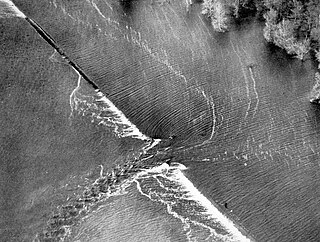
A levee breach or levee failure is a situation where a levee fails or is intentionally breached,causing the previously contained water to flood the land behind the levee.
Saint Marcellus's flood or Grote Mandrenke was an intense extratropical cyclone,coinciding with a new moon,which swept across the British Isles,the Netherlands,northern Germany,and Denmark around 16 January 1362,causing at least 25,000 deaths. The storm tide is also called the "Second St. Marcellus flood" because it peaked on 16 January,the feast day of St. Marcellus. A previous "First St. Marcellus flood" had drowned 36,000 people along the coasts of West Friesland and Groningen on 16 January 1219.

The Burchardi flood was a storm tide that struck the North Sea coast of North Frisia,Dithmarschen and southwest Jutland on the night between 11 and 12 October 1634. Overrunning dikes,it shattered the coastline and caused thousands of deaths and catastrophic material damage. Much of the island of Strand washed away,forming the islands Nordstrand,Pellworm and several halligen.

St. Lucia's flood (Sint-Luciavloed) was a storm tide that affected the Netherlands and Northern Germany on 13/14 December 1287 (OS),St. Lucia Day and the day after,killing approximately 50,000 to 80,000 people in one of the largest floods in recorded history. A low-pressure system mixed with a high tide caused the North Sea to rise over the seawalls and dikes,causing a large portion of the Netherlands and Northern Germany to be flooded.

Büsum is a fishing and tourist town in the district of Dithmarschen,in Schleswig-Holstein,Germany. It is situated on the North Sea coast,approx. 18 km southwest of Heide.
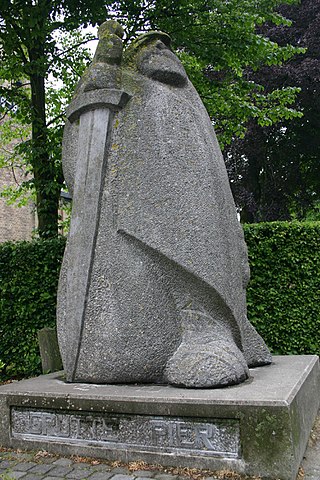
Frisia is a small region in the north of the modern day country known as the Netherlands. In the Iron Age,the ancestors of the modern Frisians first migrated south out of modern day Scandinavia to the south west where they began to settle along the coast. The archeological record goes all the way back to the Neolithic era,however,the first written sources for Frisian history come from Roman records,like Tacitus' account of an unsuccessful Frisian attack on a Roman fort. Frisia would go on to distinguish itself culturally from other Germanic peoples but remained recognizably Germanic nonetheless. In the Early Medieval era,Frisians took the seas with well crafted ships to perform trade and to raid other ports,cities,and towns in other parts of Europe. For most of its modern history,Frisia,or Frysland,has been under the control of the Netherlands but today their language is co-official with Dutch at the provincial level. Frisian is the most closely related language to English aside from Scots.

St. Peter's flood refers to two separate storm tides that struck the coasts of Netherlands and Northern Germany in 1651. During the first storm tide,on 22 February,the East Frisian island of Juist was split in two. During the second disaster,on 4–5 March,the city of Amsterdam was flooded.
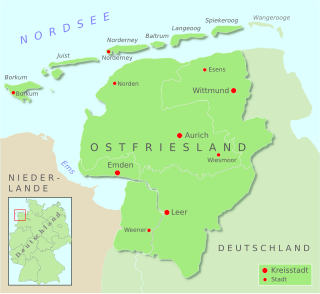
The Leybucht is the second largest bay in East Frisia in northwest Germany after the Dollart. The Jade Bight is larger than both,but belongs historically to Oldenburg.

The February flood of 1825,also known in Germany as the Great Hallig Flood,was a devastating flood that occurred from 3 to 5 February 1825 on the North Sea coast in which about 800 people were drowned. The flood devastated farmland in the region,causing an economic crisis.

Cyclone Andrea was an intense European windstorm that affected western and central Europe in early January 2012.
